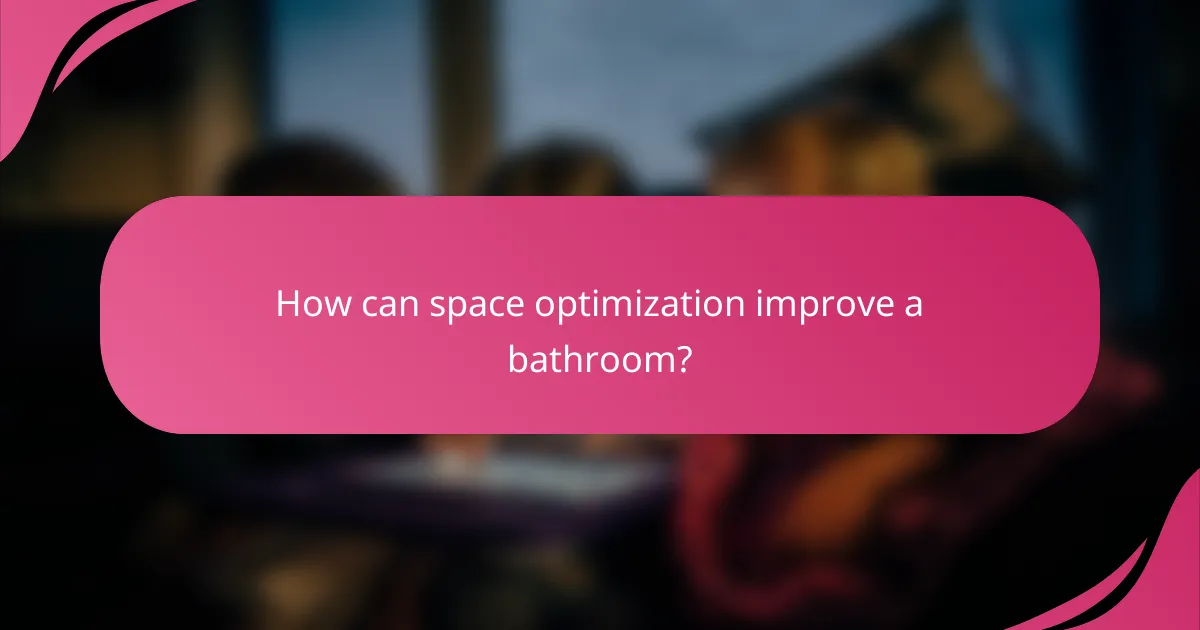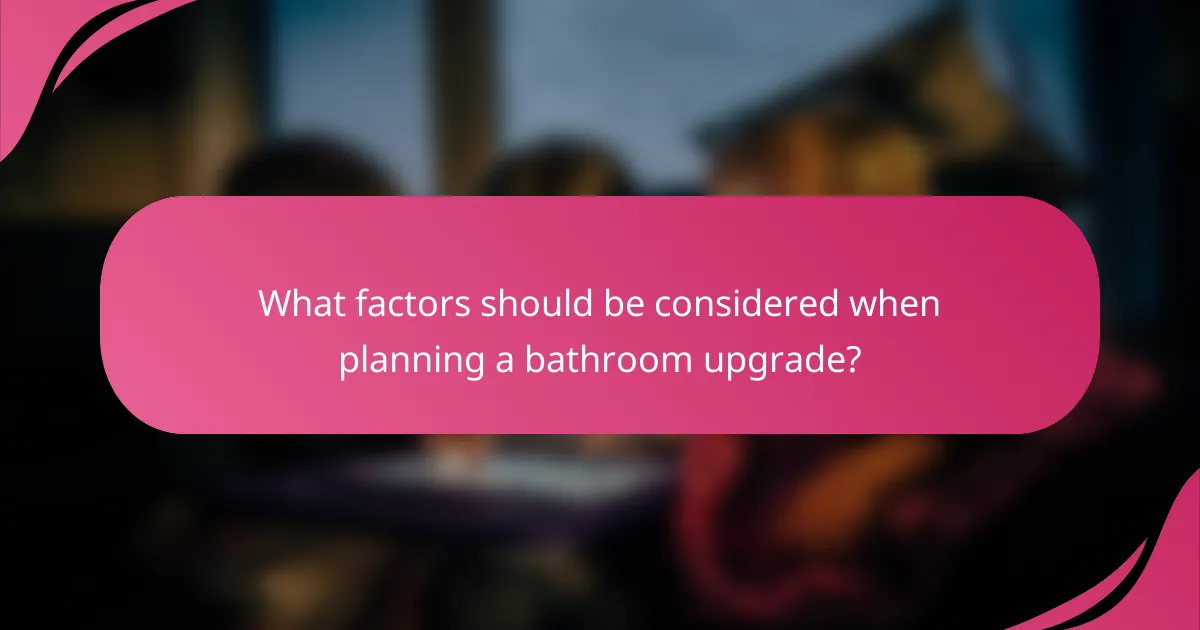Upgrading your bathroom with luxury features can transform it into a sanctuary of comfort and style. Incorporating elements like heated flooring and smart mirrors enhances both aesthetics and functionality, while strategic space optimization can make even the smallest bathrooms feel more expansive. Additionally, essential plumbing improvements, such as low-flow toilets and water-efficient fixtures, promote sustainability and elevate the overall user experience.

What luxury features can enhance a bathroom upgrade in Canada?
In Canada, luxury bathroom upgrades can significantly improve both comfort and functionality. Key features like heated flooring, smart mirrors, and high-end fixtures not only elevate the aesthetic but also enhance the overall user experience.
Heated flooring
Heated flooring provides a cozy touch to your bathroom, especially during cold Canadian winters. This feature typically involves electric heating mats or hydronic systems that warm the floor surface, making it comfortable to walk on.
When considering heated flooring, think about the installation costs, which can range from CAD 15 to CAD 30 per square foot. It’s essential to ensure proper insulation to maximize efficiency and minimize energy costs.
Smart mirrors
Smart mirrors are equipped with technology that can display information such as weather updates, news, and even your calendar. These mirrors often come with built-in lighting and defogging features, enhancing both functionality and style.
When selecting a smart mirror, look for options with touch controls and Bluetooth connectivity. Prices can vary widely, typically starting around CAD 200 and going up depending on features and size.
Rainfall showerheads
Rainfall showerheads create a spa-like experience by mimicking the sensation of standing in a gentle rain. These fixtures often feature larger diameters and multiple spray settings for a luxurious shower experience.
Installation can be straightforward, but ensure your plumbing can support the water flow needed for optimal performance. Expect to spend between CAD 100 and CAD 300 for a quality rainfall showerhead.
Freestanding bathtubs
Freestanding bathtubs serve as a stunning centerpiece in any bathroom, offering a luxurious soaking experience. They come in various styles, from modern to classic, allowing for customization to fit your design aesthetic.
Consider the space available, as these tubs require more room than traditional built-in options. Prices can range from CAD 1,000 to CAD 5,000, depending on the material and design.
High-end fixtures
High-end fixtures, including faucets and shower controls, can dramatically enhance the look and feel of your bathroom. Options in polished chrome, brushed nickel, or matte black can add a touch of elegance.
When choosing fixtures, prioritize durability and ease of maintenance. Expect to invest anywhere from CAD 200 to CAD 1,000 for premium fixtures, depending on the brand and finish. Always check for water efficiency ratings to ensure compliance with Canadian standards.

How can space optimization improve a bathroom?
Space optimization can significantly enhance a bathroom by maximizing functionality while creating a more open and inviting atmosphere. By implementing strategic design choices, you can make even small bathrooms feel more spacious and efficient.
Wall-mounted vanities
Wall-mounted vanities are a popular choice for optimizing bathroom space. By elevating the vanity off the floor, they create an illusion of more floor area, making the room appear larger. Additionally, they provide easy access for cleaning underneath, which is often overlooked in traditional vanities.
When selecting a wall-mounted vanity, consider the height and width to ensure it fits your space without overwhelming it. Aim for a vanity that offers sufficient storage while maintaining a sleek profile, ideally with a depth of around 18 to 24 inches.
Corner sinks
Corner sinks are an excellent solution for maximizing limited bathroom space. By utilizing corners, these sinks free up valuable wall space for other fixtures or storage options. They are particularly useful in smaller bathrooms where every inch counts.
When choosing a corner sink, look for compact designs that still provide adequate basin size. Ensure that the plumbing can accommodate the unique installation requirements, and consider materials that complement your overall bathroom aesthetic.
Sliding shower doors
Sliding shower doors can greatly enhance space efficiency in a bathroom. Unlike traditional swinging doors, sliding doors do not require additional clearance, allowing for more flexible use of space. This feature is especially beneficial in tighter layouts.
When selecting sliding doors, consider the material and style that best fits your design. Glass options can make the space feel more open, while framed doors can offer additional durability. Ensure proper installation to prevent leaks and maintain functionality.
Vertical storage solutions
Vertical storage solutions are key to keeping a bathroom organized without sacrificing floor space. Utilizing wall-mounted shelves, tall cabinets, or over-the-toilet storage can help maximize vertical areas, providing ample room for toiletries and towels.
When implementing vertical storage, prioritize accessibility and aesthetics. Use baskets or bins to keep items organized and consider open shelving for frequently used items. Aim for a height that is easy to reach, typically between 48 to 72 inches from the floor.

What plumbing improvements are essential for a bathroom upgrade?
Essential plumbing improvements for a bathroom upgrade include installing low-flow toilets, upgrading piping materials, and incorporating water-efficient faucets. These enhancements not only promote sustainability but also improve overall functionality and comfort in your bathroom.
Low-flow toilets
Low-flow toilets are designed to use significantly less water than traditional models, typically consuming around 1.28 gallons per flush compared to 3.5 gallons or more. This reduction can lead to substantial water savings over time, making them an eco-friendly choice.
When selecting a low-flow toilet, consider models that are certified by the Environmental Protection Agency’s WaterSense program, as they meet strict efficiency criteria. Additionally, ensure proper installation to avoid leaks and maximize performance.
Upgraded piping materials
Upgrading to modern piping materials, such as PEX or PVC, can enhance the durability and efficiency of your plumbing system. These materials resist corrosion and are less prone to leaks compared to older metal pipes, which can save you from costly repairs in the long run.
When replacing pipes, consult with a licensed plumber to assess your current system and determine the best materials for your specific needs. Proper insulation of pipes can also improve energy efficiency and reduce heat loss.
Water-efficient faucets
Water-efficient faucets are designed to limit water flow while maintaining adequate pressure, typically using 1.5 to 2.2 gallons per minute. These fixtures can significantly reduce water consumption without sacrificing performance, making them a practical choice for any bathroom upgrade.
Look for faucets that have the WaterSense label to ensure they meet efficiency standards. Installing aerators can further enhance water savings by mixing air with water, providing a fuller flow while using less water.

What are the costs associated with a bathroom upgrade in Canada?
The costs of a bathroom upgrade in Canada can vary significantly based on the scope of the project, the materials used, and the complexity of the work. Homeowners should expect to spend anywhere from several thousand to tens of thousands of Canadian dollars depending on the features and upgrades they choose.
Average renovation costs
On average, a bathroom renovation in Canada typically ranges from CAD 10,000 to CAD 25,000. This price can fluctuate based on the size of the bathroom and the extent of the changes being made. For a complete overhaul, including new fixtures, tiles, and cabinetry, costs can rise significantly.
It’s essential to obtain multiple quotes from contractors to ensure competitive pricing. Keep in mind that unexpected issues, such as plumbing or electrical problems, may increase the overall cost.
Cost of luxury features
Incorporating luxury features into your bathroom can substantially increase the renovation budget. High-end items such as freestanding bathtubs, custom vanities, and smart showers can add anywhere from CAD 5,000 to CAD 15,000 to the total cost. These features not only enhance aesthetics but can also improve functionality.
When considering luxury upgrades, prioritize which features will provide the most value and satisfaction. For example, heated flooring or high-quality fixtures may offer a better return on investment compared to purely decorative elements.
Budgeting for plumbing upgrades
Plumbing upgrades are a critical aspect of any bathroom renovation and can significantly impact costs. Basic plumbing work might start around CAD 1,500, but more extensive changes, such as relocating pipes or installing new fixtures, can escalate to CAD 5,000 or more. It’s crucial to factor these expenses into your overall budget.
To avoid overspending, assess the existing plumbing system and identify necessary updates early in the planning process. Consulting with a licensed plumber can provide insights into potential issues and help you allocate funds effectively.

What factors should be considered when planning a bathroom upgrade?
When planning a bathroom upgrade, key factors include layout and design, adherence to local building codes, and selecting the right contractors. These elements will significantly influence the functionality, safety, and overall quality of your renovation.
Layout and design
The layout and design of your bathroom are crucial for maximizing space and enhancing aesthetics. Consider the placement of fixtures like the sink, toilet, and shower to ensure efficient use of space while maintaining a comfortable flow.
Utilize design principles such as symmetry and balance to create a visually appealing environment. For example, a double vanity can enhance functionality in larger bathrooms, while wall-mounted fixtures can save space in smaller areas.
Local building codes
Local building codes dictate the standards for plumbing, electrical work, and structural changes in your bathroom upgrade. Familiarize yourself with these regulations to avoid costly fines or the need for rework.
Check with your local municipality or building department to understand specific requirements, such as minimum ventilation standards or plumbing fixture specifications. Compliance ensures safety and can enhance the value of your home.
Choosing contractors
Selecting the right contractors is essential for a successful bathroom upgrade. Look for licensed and insured professionals with experience in bathroom renovations to ensure quality workmanship.
Request quotes from multiple contractors and check references or reviews to gauge their reliability. It’s advisable to discuss timelines, budgets, and any potential issues upfront to avoid misunderstandings during the project.


